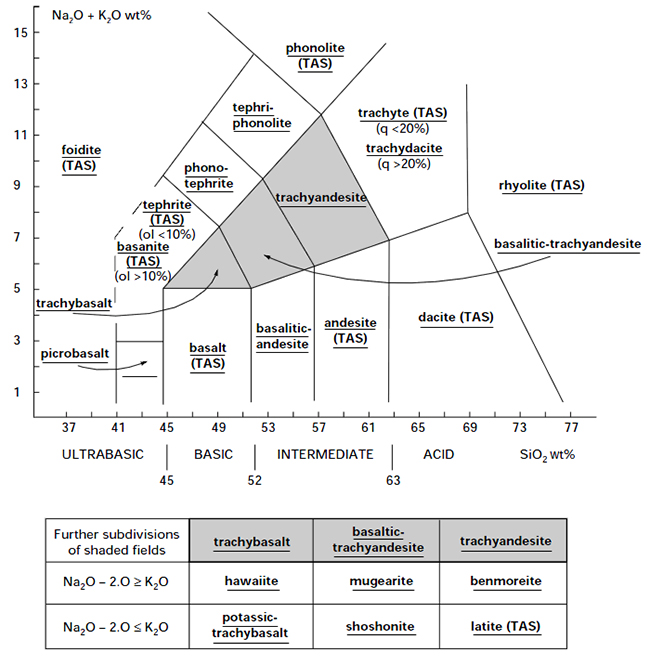Benmoreite
Benmoreite: Originally described as a member of the sodic volcanic rock series falling in compositional gap between mugearite and trachyte. It consists essentially of anorthoclase or sodic sanidine, Fe-olivine and augite. Now defined chemically as the sodic variety of trachyandesite in TAS. The term come from Ben More, Island of Mull, Scotland, UK.
Chemical classification and nomenclature of fine-grained crystalline rocks using the total alkali silica (TAS) diagram (after Le Bas et al., 1986). Rocks falling on the shaded areas may be further subdivided as shown in the table underneath the diagram. The line drawn between the foidite field and the basanitetephrite field is dashed to indicate that further criteria must be used to separate these types. Abbreviations: q = normative quartz; ol = normative olivine. From IUGS recommendations
Bibliography
• Cox et al. (1979): The Interpretation of Igneous Rocks, George Allen and Unwin, London.
• Howie, R. A., Zussman, J., & Deer, W. (1992). An introduction to the rock-forming minerals (p. 696). Longman.
• Le Maitre, R. W., Streckeisen, A., Zanettin, B., Le Bas, M. J., Bonin, B., Bateman, P., & Lameyre, J. (2002). Igneous rocks. A classification and glossary of terms, 2. Cambridge University Press.
• Middlemost, E. A. (1986). Magmas and magmatic rocks: an introduction to igneous petrology.
• Shelley, D. (1993). Igneous and metamorphic rocks under the microscope: classification, textures, microstructures and mineral preferred-orientations.
• Vernon, R. H. & Clarke, G. L. (2008): Principles of Metamorphic Petrology. Cambridge University Press.


.jpg)
.jpg)
.jpg)
.jpg)
.jpg)
.jpg)
.jpg)